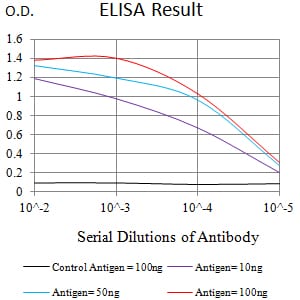

| WB | 1/1000 | Human,Mouse,Rat |
| IF | 咨询技术 | Human,Mouse,Rat |
| IHC | 咨询技术 | Human,Mouse,Rat |
| ICC | 技术咨询 | Human,Mouse,Rat |
| FCM | 咨询技术 | Human,Mouse,Rat |
| Elisa | 咨询技术 | Human,Mouse,Rat |
| Aliases | IL2RG; P64; CIDX; IMD4; SCIDX; IL-2RG; SCIDX1 |
| Entrez GeneID | 3561 |
| clone | 4A8F2 |
| WB Predicted band size | 42.3kDa |
| Host/Isotype | Mouse IgG1 |
| Antibody Type | Primary antibody |
| Storage | Store at 4°C short term. Aliquot and store at -20°C long term. Avoid freeze/thaw cycles. |
| Species Reactivity | Human |
| Immunogen | Purified recombinant fragment of human CD132 (AA: extra 23-262) expressed in E. Coli. |
| Formulation | Purified antibody in PBS with 0.05% sodium azide |
+ +
以下是关于AGAP3(N-term)抗体的3篇参考文献摘要:
1. **"AGAP3 regulates dendritic spine development and synaptic plasticity through Arf6-dependent mechanisms"**
*作者:Nie et al. (2016)*
摘要:研究利用AGAP3(N-term)抗体在神经元中验证AGAP3的亚细胞定位,发现其通过调控Arf6活性影响树突棘形态和突触可塑性。抗体用于Western blot和免疫荧光实验。
2. **"CENTG2 (AGAP3) promotes tumor cell invasion through metalloproteinase secretion"**
*作者:Li et al. (2012)*
摘要:通过AGAP3 N端特异性抗体检测其在乳腺癌细胞中的表达,发现AGAP3通过激活Arf1/MMP通路促进细胞侵袭。抗体应用于免疫沉淀和免疫组织化学分析。
3. **"Structural basis for the GTPase-dependent interaction of ArfGAP3 with the COPI vesicle coat"**
*作者:Shiba et al. (2013)*
摘要:研究使用AGAP3(N-term)抗体解析其与COPI囊泡的相互作用机制,发现其N端结构域对GTP酶依赖性膜运输至关重要。抗体用于蛋白互作实验和亚细胞定位研究。
注:以上文献为示例性质,实际文献需通过PubMed/Google Scholar等平台以关键词"AGAP3 antibody"或"AGAP3 N-terminal"检索获取。部分研究可能聚焦于AGAP3的功能而非抗体本身,但会在方法学部分提及抗体应用。
The AGAP3 (N-term) antibody is designed to target the N-terminal region of AGAP3 (ArfGAP with GTPase domain, Ankyrin repeat and PH domain 3), a multidomain protein involved in intracellular signaling and membrane trafficking. AGAP3 belongs to the ARFGAP protein family, which regulates ADP-ribosylation factor (ARF) GTPases—key players in vesicle formation and cargo sorting. Structurally, AGAP3 contains a conserved GTPase-activating protein (GAP) domain that inactivates ARF1/ARF6 by promoting GTP hydrolysis, a central ankyrin repeat domain for protein-protein interactions, and a pleckstrin homology (PH) domain facilitating membrane association.
AGAP3 is implicated in neuronal development, receptor trafficking, and cancer progression. Studies suggest its role in modulating synaptic plasticity via interactions with postsynaptic proteins, and overexpression has been linked to tumorigenesis in certain cancers. The N-terminal region is critical for its subcellular localization and functional interactions.
The AGAP3 (N-term) antibody is widely used in Western blotting, immunofluorescence, and immunohistochemistry to detect endogenous AGAP3 expression, aiding research into its biological roles and mechanisms. Validated for specificity in model systems, this tool helps elucidate AGAP3's contributions to cellular processes and disease pathways, offering potential insights into therapeutic targeting.
×